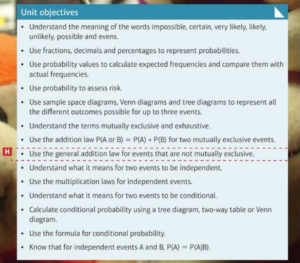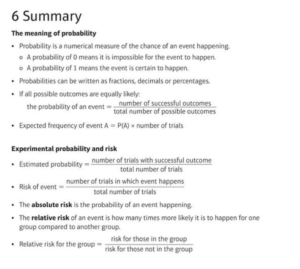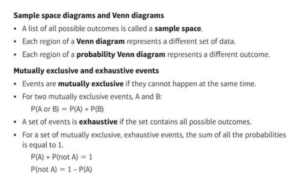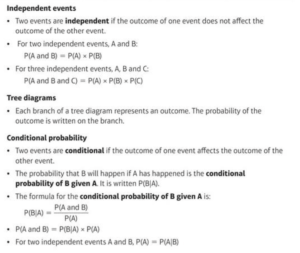6.1 The meaning of probability Link
Understand the meaning of the words impossible, certain, highly likely, likely, unlikely, possible and evens.
Use fractions, decimals and percentages to represent probabilities.
Use probability values to calculate expectedfrequencies.
6.2 Experimental probability Link
Compare expected frequencies and actual frequencies.
Understand that experimental probability will tend towards theoretical probability as the number of trials increases.
Comment on the differences between experimental and theoretical values in terms of possible bias
6.3 Using probability to assess risk Link
Determine and interpret relative risks and absolute risks.
6.4 Sample space diagrams Link
Use a sample space diagram to represent al the different outcomes possible for up to three events.
6.5 Venn diagrams Link
Use a Venn diagram to represent all the different outcomes possible for up to three events.
6.6 Mutually exclusive and exhaustive events Link
Understand the terms mutually exclusive and exhaustive.
Use the addition law P(A or B) = P(A) + P(B) for two mutually exclusive events.
6.8 Independent events Link
Understand what it means for two events to be independent.
Use the multiplication law for independent events.
6.9 Tree diagrams Link
Draw a tree diagram.
Use a tree diagram to calculate probabilities.
Conditional probability – this may be helpful Link
Other videos: The GCSE Maths Tutor
Corbett Maths Link
This is a series of videos on Conditional Probability – Khan Maths watch them one after the other.
Conditional Probability – Corbett Maths
6.10 Conditional probability Link
Understand what it means for two events to be conditional.
Calculate conditional probability using a tree diagram, two way table or Venn diagram.
6.11 The formula for conditional probability Link
Use the formula for conditional probability.
Know that for independent events A and B, P(A) = P(A|B).
6 Check up Link – cover all this section
6 Strengthen
6 Extend
6 Summary
6 Test





